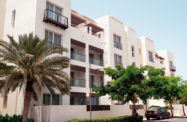The value of real estate transactions in the sultanate increased by nearly 60% year-on-year in the first five months of 2012, hitting $2.1bn in that period, with the market displaying significant demand for industry- and logistics-related facilities as well as luxury residences.
A third-quarter 2012 report released by real estate consultants Cluttons showed a major expansion in market activity for the first nine months of 2012. Philip Paul, the head of country for Cluttons in Oman, told the Times of Oman that the firm had identified increased activity in industry and logistics as a major driver of growth in the real estate sector.
“An increase in manufacturing sector and the transport and communication sector over the previous years coupled with the announcing of the GCC rail network, formation of the Customs union expected in 2015, the movement of the freight traffic from Sultan Qaboos Port to Sohar Port – all these are driving opportunities and challenges in this sector,” Paul said. “This continued growth is resulting in significant real estate requirements for warehousing facilities. The rising level of activity in logistics and warehousing space across the country is testimony to the growing confidence of domestic and international players in Oman.”
The further development of Muscat International Airport, which aims to increase freight handling capacity by 160,000 tonnes, from 100,000 to 260,000, is also expected to boost the warehousing sector.
The Cluttons report showed that demand for houses in luxury developments is expected to remain strong, as there is a shortage of such residences. In the west and centre of the country, such houses are being rented for between $2600 and $4700 per month.
According to the report, demand is likely to remain high for developments that provide a range of amenities, such as on-site gyms, parks and swimming pools. Continued high demand will likely lead to a further rise in rental prices through the end of 2012.
However, rental prices in less well-equipped complexes and developments are likely to drop in the last months of the year. Rents for mid-level housing have been moving downward relatively steadily in recent years, with average rent for a villa in western Muscat dropping from OR1450 ($3755) per month in the first quarter of 2009 to OR1100 ($2848) in the same period in 2011, according to Cluttons statistics. This downward trend is largely due to an oversupply of mid-level housing that does not necessarily meet the quality expectations of potential buyers.
While demand and prices for houses in lower-quality developments are dropping, demand for affordable housing in the sultanate – an issue the government has long been seeking to tackle – remains high. According to a report by consultancy Jones Lang LaSalle, there were approximately 300,000 low-income households (households with monthly income of less than OR450 ($1165) in Oman in 2010. There was also a shortfall of approximately 15,000 affordable homes that year. While the government has been constructing low-cost housing units – 2000 were built in 2011 and another 2000 are expected to be completed in 2012 – the rate of construction is not keeping pace with demand.
Given the sultanate’s young population and the expected increase in demand for affordable housing for young families, the Ministry of Housing has launched new initiatives with the aim of providing more options to low-income families. Indeed, in April 2012 the ministry announced plans to allocate OR80m ($207.2m) annually for affordable housing projects.
In 2011 and the first three months of 2012, the sultanate offered 3174 housing units at a total cost of OR60m ($155.4m) through the Housing Assistance Programme. In addition, 400 interest-free affordable housing loans, totalling OR7m ($18.1m), were approved through the Housing Loan Programme, according to Saif bin Amir bin Sulaiman Al Shaqsi, the undersecretary at the Ministry of Housing. The aim of the Housing Assistance Programme is to build and restore houses for families with monthly incomes of less than OR300 ($777), while the Housing Loan Programme provides interest-free loans of up to OR20,000 ($51,791) to Omani families to enable them to build their own houses.
With the growth in the logistics and industrial sectors and continued expansions at its ports and Muscat International Airport, demand for warehouses and related facilities is expected to remain high. In the residential segment, efforts are being made by the authorities to bring supply in line with demand, both in terms of addressing the housing shortfall and bringing mid-range houses up to the expectations of potential buyers and renters.

